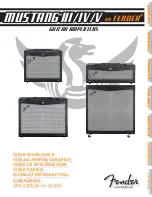
Introduction
Congratulations on purchasing the Samson S83/S63 Mixer Amplifier! In this
manual, we’ll take you on a guided tour through all the features of this powerful
and flexible device, and we’ll tell you how to get the most out of the S83/S63.
Although designed for easy operation, we suggest you take some time out first
to go through these pages so you can fully understand how we’ve implemented
a number of unique features.
The S83 and S63 both combine a flexible multi-channel mixer with a clean, pow-
erful amplifier and high-quality spring reverb unit—all in a single compact chas-
sis that mounts easily in any standard 19” rack. Simply plug in your micro-
phones and line-level instruments (such as keyboards, tape decks, CD players,
etc.) and connect the unit to any standard speaker system, and you’ve got a
complete PA system suitable for use in permanent installations such as church-
es, conference rooms, small clubs, or similar environments.
The S83 and S63 differ in the number of input channels (the S83 has eight while
the S63 has six); the type of equalization (the S83 provides four bands per chan-
nel, while the S63 has three); their amplifier power ratings (the S83 delivers 300
watts into 4 ohms, while the S63 delivers 210 watts into 4 ohms); the number of
Effects returns (the S83 has four while the S63 has two) and the presence or
absence of a master metering section, peak LEDs, and headphone preamplifier
(the S83 has all of these while the S63 does not). Both units include a 10-band
graphic master equalizer, a master level control, phantom power, two Effects
sends, and a Monitor output as well as dedicated tape/CD input.
In these pages, we’ll begin with an overview of the main S83/S63 features, fol-
lowed by a guided tour of both units’ front and rear panels. Then we’ll describe
the various input and output connections (including wiring diagrams) and tell you
in detail how to set up your S83/S63 as well as showing you how best to use the
unit in live performance. Finally, we’ll cover a number of specific topics (such as
grounding techniques, using equalization, and using the effects sends and
returns) and then wrap things up with full specifications.
Oh, and one last thing—don’t forget to fill out and mail in the enclosed warrantee
card! This will enable you to receive online technical support and will allow us to
send you updated information about other Samson products in the future.
1




































